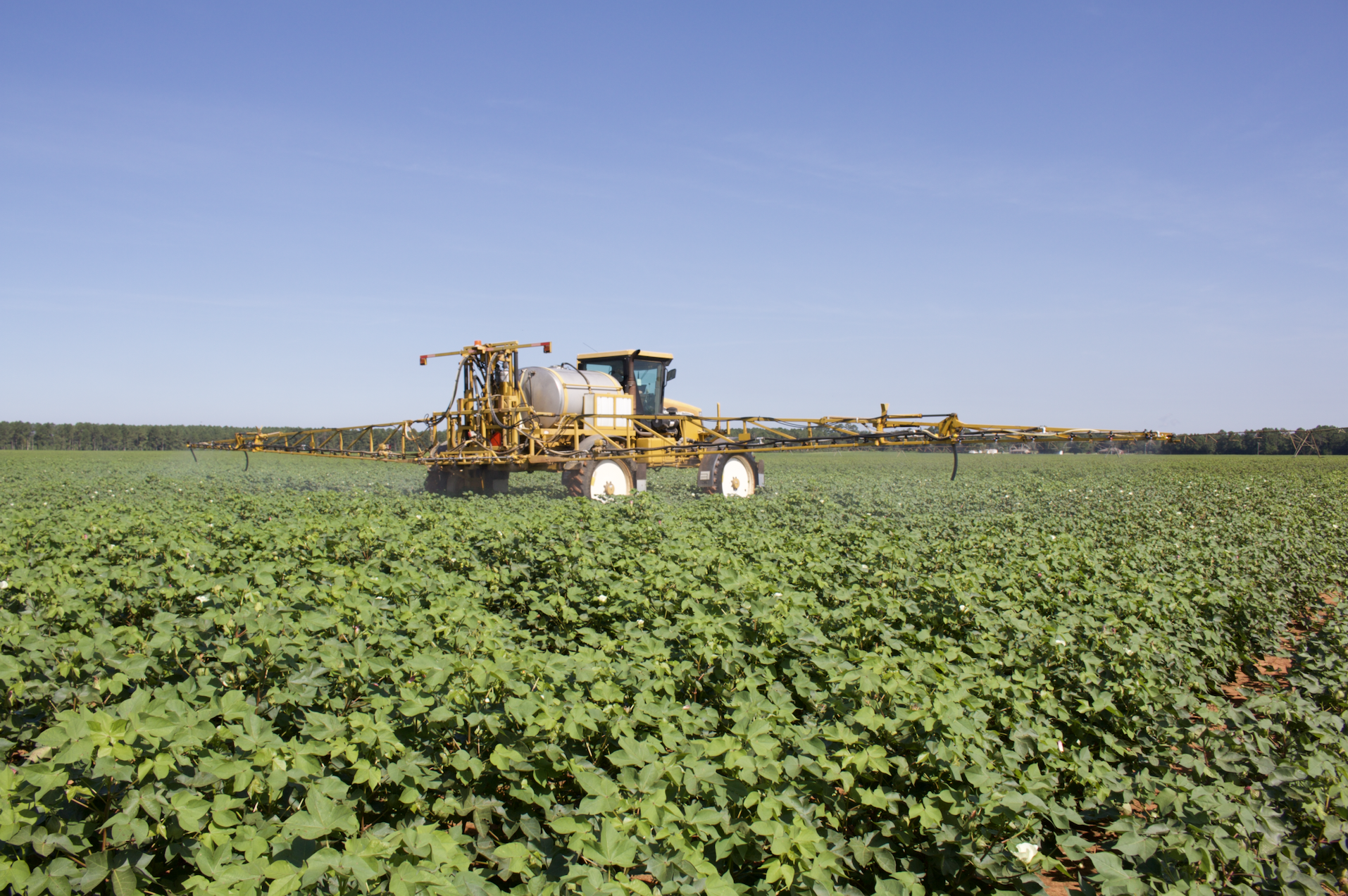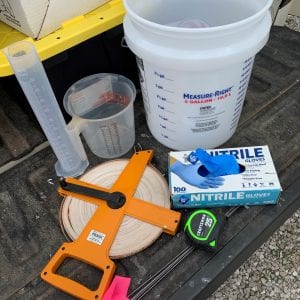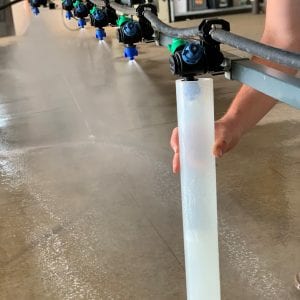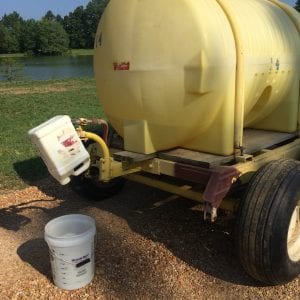Crop Production

Whether you’re planning to make a spray application in row crops or you’re controlling weeds in pastures, proper equipment calibration is essential in any pest management program.
Basic calibration involves selecting proper nozzles, output pressure, and speed of travel. Three types of sprayers are used in most cropping scenarios: boom, boomless, and handheld (pump) sprayers. The following information will help you properly calibrate boom and boomless systems.
Boom versus Boomless
Boom sprayers are most often used as tractor-mounted systems in row crop production or by small landowners using ATV-mounted equipment. Depending on the operation, booms may span a width of 4 feet up to 60-plus feet with multiple nozzles equally spaced along the boom length to deliver a uniform spray pattern. One of the benefits of a boom-type system is the precision and uniformity at which the spray solution is delivered to the target pest and the ability to deliver small spray droplets to newly emerged weeds. Problems with boom sprayers are that they may lack robustness for rough, undulating terrain, or that they may encounter obstacles, such as trees or fences, that frequently exist in pastures.
Boomless sprayers are commonly mounted on tractors or ATVs for broadcast applications in forage pastures, hayfields, or noncrop scenarios. These systems typically have a single nozzle or may be designed with up to three nozzles that produce patterns that range up to a 50-foot swath. These spray designs are useful for tight spaces, uneven terrain, brush control, or for chemically side-trimming fencerows and rights-of-way. Unfortunately, boomless nozzles are somewhat limited in precision compared to boom sprayers. For example, when output flow rates are increased or nozzle height above target is raised to extend effective swath widths, drift potential also increases. This often isn’t the best design for contact herbicides or application to newly emerged vegetation, but can be highly effective for applications of soil-active, residual chemistries and treatment of larger plants typically sprayed in forage systems.
Check Your Equipment First
- Check all lines, hoses, and tank for dry rot, cracks, holes, etc.
- Check pumps and connections for leaks.
- Remove, inspect, and clean strainers, screens, nozzles, and end caps.
- Make certain that all nozzles are the same size, have the same discharge angle, and have the appropriate screen size for the nozzle output.
- Flush the entire system with clean water.
- Replace all components and use clean water to ensure proper working order.
- Gather measuring tape, containers, gloves, stopwatch, and other equipment needed for calibration (figure 1).
- On boom sprayers, catch output from each nozzle to make certain that the output from all nozzles is within 10 percent of the average from all nozzles; replace any nozzle outside the average.
- Figure 1. Basic equipment needed for proper sprayer calibration.
- Figure 2. Calibrating a boom sprayer requires catching output from individual nozzles in fluid ounces for the calculated time.
- Figure 3. Using a clean container fitted over a boomless nozzle works well as a funnel to determine sprayer output.
Boom Sprayer Calibration
Among the many ways to calibrate a sprayer, the simplest is the 1/128 acre method, also called the baby bottle method. This method scales down the calibration course to 1/128 acre (340 feet2) because there are 128 fluid ounces in a gallon. This means that the spray collected from a single nozzle in fluid ounces directly correlates to gallons per acre (GPA) regardless of the number of nozzles on the boom.
- Fill the sprayer with clean water
- Measure nozzle spacing in inches, and then convert to feet by dividing by 12.
- Refer to the following chart to determine calibration course.
- Measure and stake off the appropriate calibration course based on nozzle spacing. The course should be on the same type of ground as that to be sprayed. (Speeds may be faster on roads than on sod, changing the application rate).
- Drive the course in the speed, gear, and rpm you will use when actually spraying. Record the time in seconds. Do this twice to get an average.
- Park the tractor or vehicle and maintain the same rpm.
- Turn on the sprayer, and catch the water from one nozzle for exactly the same time that it took to drive the calibration course (figure 2).
- Ounces caught = gallons per acre.
Boom Sprayer Calibration
| Nozzle Spacing (inches) | Length of Calibration Course1(feet) |
|---|---|
| 14” | 292’ |
| 16” | 255’ |
| 18” | 227’ |
| 20” | 204’ |
| 22” | 186’ |
| 24” | 170’ |
Boomless Sprayer Calibration
As with calculating the boom sprayer, you will need to scale down to a fraction of an acre; in this case, 1/8 of an acre (5,445 feet2) as output will be measured in pints. The sprayer output collected from the boomless nozzle measured in pints will directly correlate to gallons per acre (GPA).
- Fill the sprayer with clean water.
- Turn the sprayer on and measure the effective swath width in feet. Spray patterns are most visible on dry soil, concrete, or gravel.
- Refer to the following chart to determine calibration course:
- Drive the course in the speed, gear, and rpm you will use when actually spraying. Record the time in seconds. Do this twice and get an average.
- Park the tractor or vehicle and maintain the same rpm.
- Turn on the sprayer, and use a trash bag or other improvised funnel and bucket to catch the water for exactly the same number of seconds required to drive the calibration course (figure 3).
- Pints caught = gallons per acre (GPA).
Boomless Sprayer Calibration
| Effective Swath Width (feet) | Length of Calibration Course1 |
|---|---|
| 12’ | 454’ |
| 16’ | 340’ |
| 20’ | 272’ |
| 24’ | 227’ |
| 28’ | 194’ |
| 32’ | 170' |
| 36’ | 151' |
| 40’ | 136’ |
Points to Remember
- If your equipment does not have a pressure gauge, you can affect output (GPA) by changing speed, raising or lowering nozzle above target, or changing nozzles
- If you’re changing GPA by adjusting the pressure gauge (PSI), you must increase or decrease PSI 4x in order to double or half, respectively, GPA
- To double the output (GPA), speed (MPH) should be decreased by 50 percent.
Helpful Conversions:
- 1 acre = 43,560 feet2
- 1 gallon = 128 fluid ounces = 8 pints = 4 quarts
- 1 mph = 88 feet/sec
Download a PDF of Sprayer Calibration Made Simple, ANR-2693.





